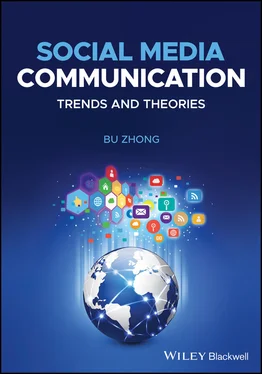7 Index
8 End User License Agreement
1 Cover
2 Title page Social Media Communication Trends and Theories Bu Zhong The Pennsylvania State University University Park, PA
3 Copyright
4 Table of Contents
5 Preface
6 Begin Reading
7 Index
8 End User License Agreement
1 i
2 ii
3 iii
4 iv
5 v
6 vi
7 vii
8 viii
9 ix
10 x
11 xi
12 xii
13 xiii
14 xiv
15 1
16 2
17 3
18 4
19 5
20 6
21 7
22 8
23 9
24 10
25 11
26 12
27 13
28 14
29 15
30 16
31 17
32 18
33 19
34 20
35 21
36 22
37 23
38 24
39 25
40 26
41 27
42 28
43 29
44 30
45 31
46 32
47 33
48 34
49 35
50 36
51 37
52 38
53 39
54 40
55 41
56 42
57 43
58 44
59 45
60 46
61 47
62 48
63 49
64 50
65 51
66 52
67 53
68 54
69 55
70 56
71 57
72 58
73 59
74 60
75 61
76 62
77 63
78 64
79 65
80 66
81 67
82 68
83 69
84 70
85 71
86 72
87 73
88 74
89 75
90 76
91 77
92 78
93 79
94 80
95 81
96 82
97 83
98 84
99 85
100 86
101 87
102 88
103 89
104 90
105 91
106 92
107 93
108 94
109 95
110 96
111 97
112 98
113 99
114 100
115 101
116 102
117 103
118 104
119 105
120 106
121 107
122 108
123 109
124 110
125 111
126 112
127 113
128 114
129 115
130 116
131 117
132 118
133 119
134 120
135 121
136 122
137 123
138 124
139 125
140 126
141 127
142 128
143 129
144 130
145 131
146 132
147 133
148 134
149 135
150 136
151 137
152 138
153 139
154 140
155 141
156 142
157 143
158 144
159 145
160 146
161 147
162 148
163 149
164 150
165 151
166 152
167 153
168 154
169 155
170 156
171 157
172 158
173 159
174 160
175 161
176 162
177 163
178 164
179 165
180 166
181 167
182 168
183 169
184 170
185 171
186 172
187 173
188 174
189 175
190 176
191 177
192 178
193 179
194 180
195 181
196 182
197 183
198 184
199 185
200 186
201 187
202 188
203 189
204 190
205 191
206 192
207 193
208 194
It is never easy to live a year in a foreign city that is 8,000 miles away from home, especially for a 10-year-old.
Following his father’s sabbatical leave to Asia, Skyler, 10, left his American school to attend, reluctantly, his 5th grade year in Guangzhou, China. This was the biggest challenge he has had so far. He was old enough to know that living there for a year could be quite different from visiting it for a couple of days. Unsurprisingly, Skyler’s initial adjustment to his Guangzhou school was a disaster due to language barriers, cultural shocks, a different pedagogy, and “endless” homework, even on holidays.
The most unbearable, above all, was the detachment from his American friends, causing him a kind of “social pain.” Social pain can be as bad as physical pain, if not worse. This is well supported by a growing body of evidence from studies by neuroscientists and psychologists (Almehmadi et al., 2013; Stafford & Bell, 2012; Viale, 2011). By analyzing magnetic resonance imaging (MRI) results, Matthew Lieberman (2013), a professor of psychology and biobehavioral sciences at the University of California, Los Angeles, found that both physical and social pains were linked to the same brain region. Looking at MRI scans from two studies side by side, one on physical pain and the other on social pain, Lieberman and colleagues could detect little difference between them. Next time he felt down, he said he might reach for Tylenol (Lieberman, 2013).
Skyler did not need Tylenol to relieve social pain. He felt better as soon as he made new friends. The pain was completely gone after he returned home one year later. Recalling the experience, he said the most scaring part was being there without “old” friends. His experience clearly exemplifies the importance of staying social. We all are essentially social beings that are driven by deep motivations to be connected with others (Lieberman, 2013). The mutual influence is critical to one’s well-being.
This helps explain why social media have become such an integral part of modern life, transforming the world in almost every aspect, in particular, communication and business. The popularity of social media, to many, might be plausibly attributed to the influx of new media technologies. The vital driving force behind it, however, is nothing but the trait of people being socially wired. This is consistent with the ample evidence from psychologists, who have discovered that the desire to form and maintain interpersonal attachments – the need to belong – is a fundamental human motivation (Baumeister & Leary, 1995).
Fundamentally, our minds are hardwired to be social.
Nowadays, social media are an essential multifunctional platform for us to obtain information and knowledge, share thoughts and ideas, and, simply, communicate with one another. As we live much of our lives on social media, the knowledge of online tools is not just something “nice to have,” but a capability we need to survive and excel in this social media era. At an individual level, social media know-how contributes to one’s success in the twenty-first century, while at the societal level, the know-how adds up to “a more thoughtful society” (Rheingold, 2012, p. 2).
In other words, what you do not know may be too much to afford. However, a good knowledge concerning how social media work, especially the mechanism of social media use, does not happen to us automatically. Social media have brought about new ways of communication humans did not experience before. This is not to say that they have totally replaced the old ways. We may not be completely wired to social media, but there is no doubt that social media are playing a critical role in our daily lives.
This book is thus designed to explore the power of social media, how social media evolve and change the human mind and behavior, how they affect information processing, the media industry and business marketing, as well as interpersonal and group communication. In other words, it is about how people live and work through, with, and around social media in various communication and business contexts.
Each chapter will center on an important topic with the power to change the ways you see and use social media, – for example, how social media evolve and affect people’s information processing, the media industry and business marketing, in particular interpersonal and group communication powered by social media. After reading the chapters in this book, the reader should have an in-depth understanding on how social media are transforming humanity, communication, and business.
This book, however, is not about the wonders of social media, even though it explores social media and their social implications. Nor does it use particular forms of social media as the focal point, whether it be Facebook, Twitter, or TikTok. Otherwise the book would be instantly outdated, as social media, like it or not, never stop evolving. Hence, this book focuses on two areas – an in-depth understanding of the social media mechanism and its impact on human communication and how people may make the best use of social media in the areas of communication and business.
Читать дальше












